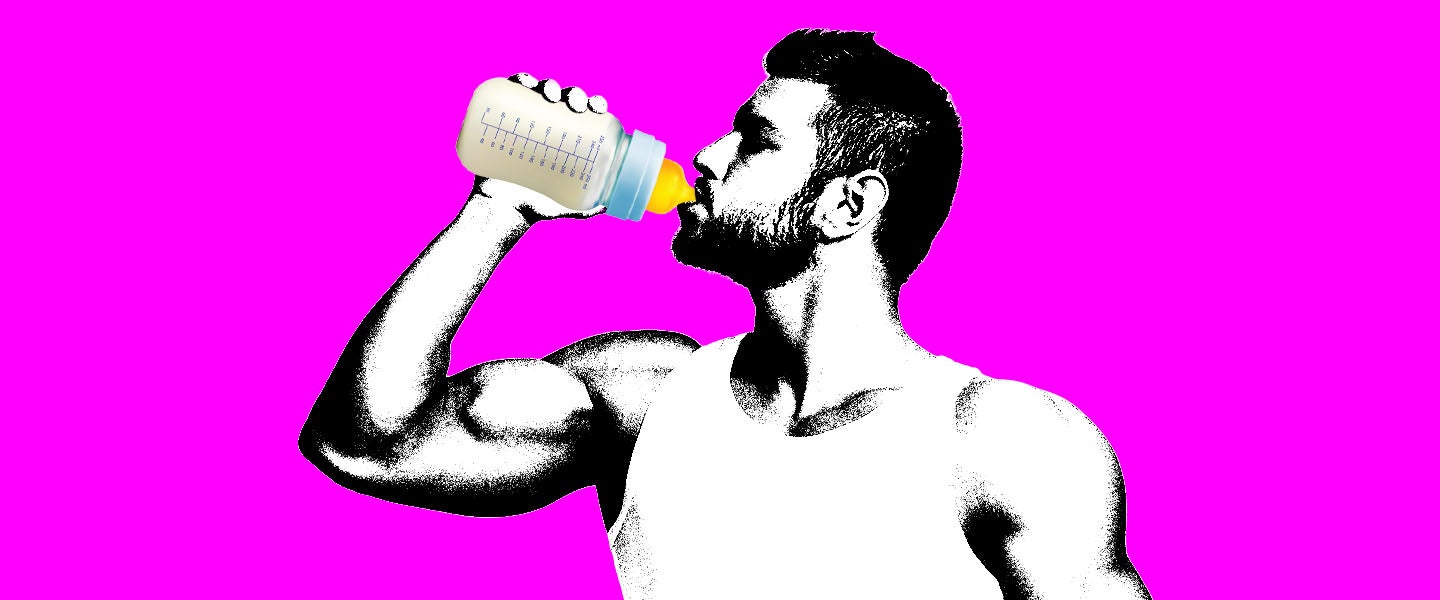A 29-year-old Australian gym rat called Chodie is telling me all about his breast milk diet.
He gets it straight from his partner, he says, and gulps down “a couple of mouthfuls a time, maybe twice a week.” There’s plenty to go around, and Chodie’s partner doesn’t mind him skimming the excess of what’s meant for their daughters. Of course, her tolerance has limits: “Getting it was really easy using a pump, and getting it ‘on tap’ was easy enough too, but my partner ended up finding this too strange,” he says. “Fair enough!”
Chodie’s lucky. Other bodybuilders have to surf the web to get their fix. This trend has led to a recent spike in online unregulated sales of human breast milk to adult men.
It can be a lucrative business, too. Rafaela Lamprou, who was highlighted in the New York Post, reportedly made more than $6,000 selling her breast milk to men between August 2017 and March 2018. Lamprou and other women use websites like OnlyTheBreast.com — a classifieds page for breast milk, originally intended for women to sell to other women who struggle to produce — to sell to male bodybuilders looking to gain weight and bulk up.
A quick search of “human breast milk” on Reddit’s fitness and bodybuilding subreddits reveals pretty much what you’d expect: a lot of dudes wondering what breast milk will do for their lifting.
Would there be any benefit in drinking breast milk opposed to cow or other commercially available milk for muscle growth? from Fitness
My friend confessed that his wife breastfeeds him for better gains… from bodybuilding
Breast Feeding For Gainz. Is this a thing? from bodybuilding
According to the USDA, 8 ounces of human breast milk contains about 2.5 grams of protein, 10 grams of fat, 172 calories and 16 grams of carbs — decidedly less protein per ounce than cow’s milk. But bodybuilders know this. It’s not the protein they’re after; it’s the human growth hormone present in human breast milk. Insulin-like growth factor, or IGF, shortens recovery time by growing and repairing muscle tissues at a rapid rate.
It’s for this reason you’ll find bodybuilders raving about the stuff. “Anyone who is not lactose intolerant is selling his gains short if he is not supplementing with breast milk and a lot of it,” writes bodybuilding.com forum user Lefticle.
“I always drank breast milk, I like it, but I never fully realized its potential as a supplement until I started using it as the cornerstone of my diet and started growing beyond measure. I made the greatest gains of my life on breast milk, an unrivaled 35 pounds in 10 months.”
If this sounds too good to be true, it’s probably because it is. Buying human breast milk is not only expensive (OnlyTheBreast prices range from $1 and $5 per ounce), but it’s unregulated. For Yahoo!, Dr. Maureen Groer, a professor and lactation researcher at the University of South Florida College of Nursing, warns against buying milk online:
“There’s no way to know what diseases the woman who pumped the milk might have. How did she pump it? Were the pump parts sterile? Were the bottles used to store it sterile? Milk is a wonderful medium for bacterial growth if it’s not properly managed. … The women [who donate to government-regulated milk banks] are tested for viruses like HIV and hepatitis. And the milk is handled carefully — it’s pasteurized, it’s pooled, and it’s flash-frozen, and delivered frozen to the hospitals that use it.”
Beyond these risks, bodybuilders who opt for human breast milk ignore the fact that colostrum — the milk produced by all mammals that contains growth hormone — is just that: produced by all mammals. Bovine colostrum is widely available, and according to colostrum distributor Sovereign Labs, it “includes a higher concentration of an insulin-like growth factor (IGF) than human colostrum” and “includes a higher concentration of casein, a protein that provides the building blocks of muscle, than its human counterpart.”
Thus, Sovereign Labs concludes, “benefits of bovine colostrum may actually outweigh those associated with its human counterpart.”
But science has never gotten in the way of dudes looking to get swole. Chodie illustrates this beautifully: “Curiosity and opportunity is what lead me to [drink breast milk],” he says. “I didn’t think it would provide an advantage in terms of getting any better gains than just regular, consistent, healthy, food-for-fuel eating and workout habits.” Still, “I’d read that it is probably a very good source of nutrients.”
Chodie admits his habit has petered out. His partner wasn’t “able to produce a surplus amount all the time. Some women are gifted in this area, but she was not.” What’s more, the breast milk diet became more of a hassle than it was worth — and he’s not convinced it helps much, either. “I’ve always found putting on muscle very easy,” he concludes, “and I can’t say whether I noticed any gains of any sort through it.”
That, and because getting it straight from the breast was “too weird for her.”
“Getting it from the tap during naughty times meant having to distract her first,” he says, “and doing it casually, well, that’s how she normally feeds the kids… the vibe was too weird, and I respected that.”

